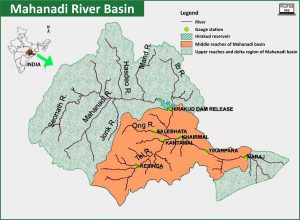02 Nov Debrigarh Wildlife Sanctuary
This article covers “Daily Current Affairs” and the topic details “ Debrigarh Wildlife Sanctuary”. This topic has relevance in the Environment section of the UPSC CSE exam.
GS 3: Environment
Why in the news?
Wildlife enthusiasts have been thrilled by a rare sighting of a pair of elusive wild dogs, commonly known as Dholes, in the Debrigarh Wildlife Sanctuary located in Bargarh district, Odisha.
About Debrigarh Wildlife Sanctuary:
- Location:Debrigarh Wildlife Sanctuary, located in the state of Odisha, is situated near Mahanadi River’s Hirakud Dam and its reservoir.
- Establishment: This wildlife sanctuary was declared as such in the year 1985.
- Historical Significance: Debrigarh Wildlife Sanctuary holds historical significance due to its association with the renowned freedom fighter, Veer Surendra Sai. During his resistance against British colonial rule, Veer Surendra Sai used “Barapathara,” a location within the sanctuary, as his base of operations.
- Fauna: The sanctuary is known for its diverse wildlife, making it relatively easy to spot animals like Indian Bison, Wild Boars, and Sambhar.
- Flora: The sanctuary features a dry deciduous forest that attracts a wide variety of bird species, particularly during the winter months.
Key Facts about Dhole (Wild Dogs):
-
- Distribution: Dholes, also known as wild dogs, are found in the forests of central, south, and southeast Asia. They inhabit a vast range, from as far north as Siberia to as far south as some Malaysian islands and as far west as the Indian peninsula. In India, they are clustered in three primary regions: the Western and Eastern Ghats, the central Indian landscape, and North East India. The Western and Eastern Ghats are particularly strongholds for dhole populations.
- Habitat: Dholes can be found in various habitats, including dense jungles, steppes, mountains, scrub forests, and pine forests.
- Conservation Status:
-
- IUCN: Endangered
- CITES: Appendix II
- The Wildlife Protection Act 1972: Schedule II
Key Points About Mahanadi River:
- Overview: The Mahanadi River system is the third largest river system in peninsular India, following the Godavari and Krishna rivers. It holds the distinction of being the largest river in the state of Odisha.
- Catchment Area: The river’s catchment area extends across multiple states, including Chhattisgarh, Madhya Pradesh, Odisha, Jharkhand, and Maharashtra.
- Geographic Boundaries: The basin of the Mahanadi River is demarcated by geographical features, including the Central India hills to the north, the Eastern Ghats to the south and east, and the Maikala range to the west.
- Source: The Mahanadi River originates near Sihawa, close to Raipur in the state of Chhattisgarh, to the south of Amarkantak.
- Major Tributaries: The river is fed by several significant tributaries, including the Seonath, Hasdeo, Mand, and Ib, joining from the left side, and the Ong, Tel, and Jonk, joining from the right.
- Mahanadi River Dispute: In 2018, the Central Government established the Mahanadi Water Disputes Tribunal to address issues related to the river’s water usage and allocation.
- Major Dams/Projects: Notable dams and projects on the Mahanadi River include the Hirakud Dam, which is the longest dam in India, as well as the Ravishankar Sagar, Dudhawa Reservoir, Sondur Reservoir, Hasdeo Bango, and Tandula projects.
- Urban Centers: Within the basin of the Mahanadi River, three significant urban centers are Raipur, Durg, and Cuttack.
- Industries: The Mahanadi basin is conducive to industrial development due to its rich mineral resources and ample power resources. Industries in the region encompass iron and steel plants in Bhilai, aluminum factories in Hirakud and Korba, a paper mill near Cuttack, a cement factory in Sundargarh, and other agro-based sectors such as sugar and textile mills. Additionally, the basin supports coal, iron, and manganese mining activities.

SOURCE: Wild dogs resurface in Odisha’s Debrigarh Sanctuary – The Hindu
Download plutus ias current affairs eng med 02nd Nov 2023
Q.1 Which of the following statements regarding Debrigarh Wildlife Sanctuary is accurate?
- Debrigarh Wildlife Sanctuary is situated near the Brahmaputra River’s Hirakud Dam.
- Veer Surendra Sai, a famous freedom fighter, used the sanctuary as his base during his resistance against the British colonial rule.
Which of the statements given above is/are correct?
(a) 1 only
(b) 2 only
(c) Both 1 and 2
(d) Neither 1 nor 2
Q.2 Which of the following statements regarding the Mahanadi River and its features are correct?
- The Mahanadi River’s catchment area includes the states of Chhattisgarh, Madhya Pradesh, Odisha, Jharkhand, and Maharashtra.
- The Mahanadi River originates near Amarkantak in the state of Madhya Pradesh.
- The Hirakud Dam is the longest dam in India and is built on the Mahanadi River.
How many of the above statement/s is/are correct?
(a) Only one
(b) Only two
(c) All three
(d) None
Q.3 Explain the significance of river drainage systems in shaping the physical and human geography of a region.



No Comments